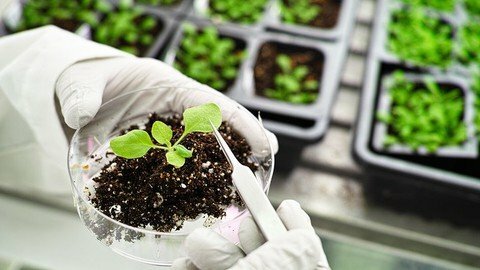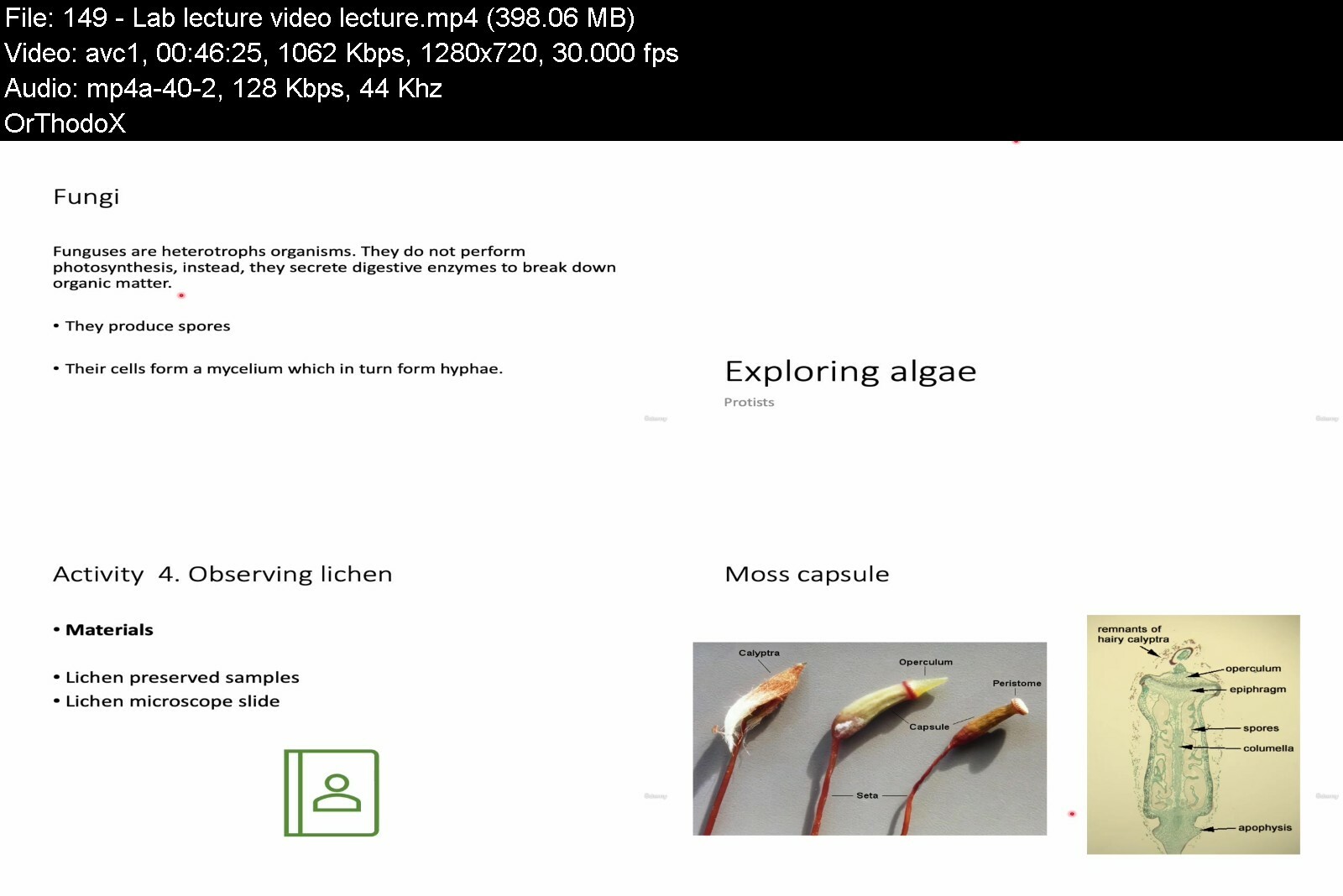
Introduction To Plant Biology And Botany
Published 9/2022
MP4 | Video: h264, 1280x720 | Audio: AAC, 44.1 KHz
Language: English | Size: 6.07 GB | Duration: 14h 12m
Biology of plants
What you'll learn
You will be able to learn the principles of plant biology and botany.
You will be able to define the origin and evolution of the major plant groups.
You will be able to understand the scientific naming of plants.
You will be able to recognize plants' morphological characteristics.
You will be able to describe the internal structures of a plant.
You will be able to learn about the plant's physiological and biochemical activities
You will be able to learn about the scientific method and research.
Requirements
No prior knowledge or experience is required to take this course.
Description
I have designed this course to introduce you, the student, to the principles of plant biology, botany, and the scientific method. In this course, you will learn about the structural organization, classification, physiology, reproduction, heredity, and evolution of plants and photosynthetic organisms. Additionally, this course provides an overview of the plant kingdom and compares various plant groups within the kingdom. This course was primarily designed to serve as part of the general education requirements for graduation from a community college to fulfill the science requirement for associate degree graduates. I have released this course on Udemy with only minor modifications from the original course, so by taking this course you will be learning at a college level. As part of your learning process in this course, you will be able to experience college-level reading, writing, and mathematics assignments. Course major topics: The formation of planet Earth; Plants, humans, and the environment; The cell and the organelles; Cell division; The DNA, RNA, and evolution; Plant metabolism, Research and the scientific method; External factors influencing plant growth; Classification and diversity; Bacteria and fungi; Mosses; Ferns; Conifers; Flowering plants; Plant morphology and anatomy; Plant tissues; Stem and leaves; Flowers, fruits, and seeds; Animal and plant interaction.
Overview
Section 1: Introduction to the course
Lecture 1 Intro
Lecture 2 Welcome
Lecture 3 Meet your instructor
Lecture 4 Botanical and scientific terms
Lecture 5 Course overview
Lecture 6 Course bibliographic references
Section 2: Virtual laboratory: introduction to the microscope
Lecture 7 Lab lecture (worksheet)
Lecture 8 Lab lecture (video lecture)
Section 3: The cell and the organelles
Lecture 9 Overview
Lecture 10 The origins
Lecture 11 Origin of membranes
Lecture 12 Prokaryotic cells
Lecture 13 The endosymbiosis theory I
Lecture 14 The endosymbiosis theory II
Lecture 15 Plant cell vs Animal cells
Lecture 16 Plants and humans
Lecture 17 Plants and the environment
Lecture 18 The cell
Lecture 19 Unicellular and multicellular life
Lecture 20 Cell membranes
Lecture 21 Chemical composition of cell membranes and transport across membranes
Lecture 22 Plant cell wall
Lecture 23 Types of plant cell wall
Lecture 24 Plasmodesmata
Lecture 25 Plant cell organelles
Lecture 26 Cytoskeleton
Section 4: Virtual laboratory: the cell and the organelles
Lecture 27 Lab lecture (worksheet)
Lecture 28 Lab lecture (video lecture)
Section 5: Cell division: mitosis and meiosis
Lecture 29 Overview
Lecture 30 Cell division
Lecture 31 Role of mitosis and meiosis in plants
Lecture 32 The cell cycle
Lecture 33 Mitosis introduction
Lecture 34 The process of mitosis
Lecture 35 Introduction to meiosis
Lecture 36 The process of meiosis
Lecture 37 Cell checkpoints and chromosome aberration
Section 6: Virtual laboratory: cell division, mitosis and meiosis
Lecture 38 Lab lecture (worksheet)
Lecture 39 Lab lecture (video lecture)
Section 7: The DNA and RNA: gene expression, heredity and the process of evolution
Lecture 40 Overview
Lecture 41 Genetics
Lecture 42 The structure and function of DNA and RNA
Lecture 43 DNA replication
Lecture 44 From DNA to protein
Lecture 45 Heredity I
Lecture 46 Heredity II
Lecture 47 Evolution and natural selection I
Lecture 48 Evolution and natural selection II
Lecture 49 Assignment. Evolution and natural selection
Lecture 50 Factors that promote evolution
Lecture 51 Assignment. Artificial selection and genetic engineering our food
Section 8: Plant anatomy: primary and secondary growth of plants
Lecture 52 Overview
Lecture 53 Apical meristem
Lecture 54 Protoderm: epidermis
Lecture 55 Stomata
Lecture 56 Ground meristem: parenchyma, collenchyma and sclerenchyma
Lecture 57 Procambium: Vascular tissues. Xylem
Lecture 58 Procambium: Vascular tissue. Phloem
Lecture 59 Primary meristem
Lecture 60 Overview of monocot and dicot plants
Lecture 61 Root primary growth
Lecture 62 Monocot vs eudicot root
Lecture 63 Stem primary growth
Lecture 64 Monocot vs eudicot stem
Lecture 65 Secondary meristems
Lecture 66 Stem secondary growth I
Lecture 67 Stem secondary growth II
Lecture 68 Root secondary growth
Lecture 69 Anatomy of the leaf
Section 9: Virtual laboratory: plant anatomy
Lecture 70 Lab lecture (worksheet)
Lecture 71 Lab lecture (video lecture)
Section 10: Plant physiology: photosynthesis, cellular respiration and transpiration
Lecture 72 Overview
Lecture 73 Metabolism
Lecture 74 Photosynthesis and cellular respiration overview
Lecture 75 Chloroplast: sites of photosynthesis
Lecture 76 Steps of photosynthesis
Lecture 77 Chloroplast pigments
Lecture 78 The process of photosynthesis: light dependent and independent reaction
Lecture 79 Electron carriers
Lecture 80 Cellular Respiration: aerobic harvest of food energy
Lecture 81 An overview of cellular respiration
Lecture 82 Steps for cellular respiration
Lecture 83 Transpiration overview
Section 11: Virtual laboratory: plant physiology
Lecture 84 Lab lecture (worksheet)
Lecture 85 Lab lecture (video lecture)
Section 12: Research methods and methodology. Analyzing, writing, and sharing information
Lecture 86 Overview
Lecture 87 The scientific method
Lecture 88 What is a literature review?
Lecture 89 How to read a scientific article
Lecture 90 Assignment. How to read a scientific article
Lecture 91 Assignment. Paraphrasing from a scientific article
Lecture 92 APA style and citations
Lecture 93 Assignment. APA style and citations
Lecture 94 Additional resources. Citation generator
Lecture 95 Doing library research: searching for scientific articles
Lecture 96 Assignment. Doing library research: searching for scientific articles
Lecture 97 Assignment. Writing in sciences
Lecture 98 Public speaking your work
Lecture 99 Project guidelines
Section 13: Classification and diversity of plants, photosynthetic organism, and fungi
Lecture 100 Overview
Lecture 101 Cryptogams
Section 14: Prokaryotes and fungus
Lecture 102 Overview
Lecture 103 Introduction to classification of organisms
Lecture 104 Checkpoint binomial names
Lecture 105 Classification
Lecture 106 Cladistics
Lecture 107 Understanding evolutionary trees and cladograms
Lecture 108 Herbarium
Lecture 109 Kingdom monera: bacteria, cyanobacteria and archaea
Lecture 110 Importance of fungi
Lecture 111 Biology and characteristics of fungi
Lecture 112 Fungi evolution and classification
Lecture 113 Fungi as plant pathogens
Lecture 114 Lichens
Lecture 115 Mycorrhizae
Section 15: Protists and algae
Lecture 116 Overview
Lecture 117 Introduction to algal organisms
Lecture 118 Euglenoids
Lecture 119 Diatoms
Lecture 120 Red and brown algae
Lecture 121 Life cycles
Lecture 122 Green algae
Section 16: The land plants
Lecture 123 The land plants
Section 17: Classification and diversity: Bryophytes (non vascular plants)
Lecture 124 Overview
Lecture 125 The transition, water to land
Lecture 126 Introduction to bryophytes: mosses, liverworts, and hornworts
Lecture 127 Gametophyte and sporophyte
Lecture 128 Division Anthocerotophyta overview
Lecture 129 Hornworts gametophyte
Lecture 130 Hornworts sporophyte
Lecture 131 Division Bryidae overview
Lecture 132 Mosses gametophyte morphology
Lecture 133 Moss sporophyte morphology
Lecture 134 Liverworts gametophyte
Lecture 135 Liverworts sporophyte
Lecture 136 Bryophytes reproduction
Section 18: Classification and diversity: Pteridophytes (Vascular plant)
Lecture 137 Overview
Lecture 138 Extinct vascular plants
Lecture 139 Recent vascular plants
Lecture 140 Lycophytes
Lecture 141 Selaginellacea life cycle
Lecture 142 Ferns overview
Lecture 143 Fern allies
Lecture 144 Eusporangiate and leptosporangiate ferns
Lecture 145 True ferns I
Lecture 146 True ferns II
Lecture 147 Ferns life cycle
Section 19: Virtual laboratory. Cryptogams
Lecture 148 Lab lecture (worksheet)
Lecture 149 Lab lecture (video lecture)
Section 20: Classification and diversity: Gymnosperms and Angiosperms (Vascular)
Lecture 150 Overview
Lecture 151 Gymnosperms classification and diversity. The seed
Lecture 152 Extinct seed plants
Lecture 153 The phanerogams. Living seed plants
Lecture 154 Living gymnosperms
Lecture 155 Pinidae I
Lecture 156 The pine cone
Lecture 157 Pinidae II
Lecture 158 The other living gymnosperms
Lecture 159 Introduction to flowering plants
Lecture 160 Monocots and Eudicots
Lecture 161 Classification of angiosperms
Lecture 162 Sporogenesis, gametogenesis and embryogenesis
Section 21: Virtual laboratory. Phanerogams
Lecture 163 Lab lecture (worksheet)
Lecture 164 Lab lecture (video lecture)
Section 22: Plant morphology
Lecture 165 Overview
Section 23: General morphology of angiosperms. Roots, stems and leaves
Lecture 166 Overview
Lecture 167 Type of roots and root modification
Lecture 168 Stems
Lecture 169 Relationship between the vascular tissues of the stem and the leaf
Lecture 170 Leaves
Lecture 171 Leaf and leaflets
Lecture 172 Leaf venation
Lecture 173 Leaf margin and texture
Lecture 174 Leaf shape and leaf apex and base
Lecture 175 Leaf indumentum
Lecture 176 Leaf phyllotaxy
Lecture 177 Leaf modifications
Section 24: Virtual laboratory. Roots, stems, and leaves
Lecture 178 Lab lecture (worksheet)
Lecture 179 Lab lecture (video lecture)
Section 25: General morphology of angiosperms: flowers, fruits, and seeds
Lecture 180 Overview
Lecture 181 The flower
Lecture 182 Floral morphology I
Lecture 183 Floral morphology II
Lecture 184 Floral morphology III
Lecture 185 Floral symmetry
Lecture 186 Fusion of the flower parts
Lecture 187 Floral insertion
Lecture 188 Placentation
Lecture 189 Inflorescences I
Lecture 190 Inflorescences II
Lecture 191 Assignment. Pollen and evolution
Lecture 192 The fruit
Lecture 193 Fruit classification
Lecture 194 Fruit types
Lecture 195 The seed
Lecture 196 Seed dispersal
Section 26: Virtual laboratory. Flowers, fruits, and seeds
Lecture 197 Lab lecture (worksheet)
Lecture 198 Lab lecture (video lecture)
Section 27: Public presenting your class project: discussion board
Lecture 199 Public specking your work
Lecture 200 Guidelines
Section 28: Congratulations in concluding the course!
Lecture 201 Final evaluation of the course
Lecture 202 My links
Plants and botany enthusiasts, and those interested in the biological and scientific background associated with plants, can benefit from the course.
https://anonymz.com/?https://www.udemy.com/course/introduction-to-plant-biology-and-botany/

download скачать from RapidGator
https://rapidgator.net/file/a46e9eb004242cc9a97a6156c5f1d426/Introduction_to_plant_biology_and_botany.part1.rar https://rapidgator.net/file/b7404df6811f132d4cda2615d6093650/Introduction_to_plant_biology_and_botany.part2.rar https://rapidgator.net/file/877524ab43035304370f7482496a1700/Introduction_to_plant_biology_and_botany.part3.rar https://rapidgator.net/file/1b35a78b85eef6440bc522f43a74ec72/Introduction_to_plant_biology_and_botany.part4.rar
download скачать from NitroFlare
https://nitroflare.com/view/9C2FAC333761DC9/Introduction_to_plant_biology_and_botany.part1.rar https://nitroflare.com/view/5BA38EBF730EF01/Introduction_to_plant_biology_and_botany.part2.rar https://nitroflare.com/view/AAAEB3ECCB943C3/Introduction_to_plant_biology_and_botany.part3.rar https://nitroflare.com/view/5257CCDD95808FD/Introduction_to_plant_biology_and_botany.part4.rar

